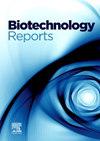Microalgae strains isolated from piggery wastewater in Ecuador: Effective nitrogen compound removal and growth potential in extremophile conditions
Q1 Immunology and Microbiology
引用次数: 0
Abstract
Effluents generated by anthropogenic activities are a significant source of pollution and eutrophication in natural water bodies. In Ecuador, the increase in pig production has exacerbated this issue due to the untreated discharge of pig effluents. This study focused on the characterization of native microalgae present in pig effluents and the evaluation of their capacity to remove nitrogenous compounds under various conditions, with the aim of identifying efficient strains for phycoremediation. Four microalgal strains were isolated and molecularly identified as Radiococcus polycoccus, Chlorolobion braunii, Micractinium sp., and Desmodesmus multivariabilis. The cultures were exposed to initial concentrations of 100 mg L-1 N-NH₄ and 49.97 mg L-1 N-NO₃ for 12 days to assess their cellular growth and nutrient removal rates. Growth kinetics were analyzed under conditions of 2000 mg L-1 N-NH₄ and extreme pH levels of 3 and 10. Chlorolobion braunii demonstrated the highest productivity, achieving a removal of 67.73 % of N-NH₄ and 30.59 % of N-NO₃, and reached the highest cellular density under extreme ammonium conditions, being the only strain capable of growing at acidic pH. Conversely, Micractinium sp. exhibited the highest growth under alkaline conditions. These results highlight the promising potential of native microalgae from pig effluents for wastewater remediation and their adaptation to environmental conditions.

从厄瓜多尔养猪场废水中分离的微藻菌株:在极端微生物条件下有效去除氮化合物和生长潜力
人为活动产生的污水是自然水体污染和富营养化的重要来源。在厄瓜多尔,由于未经处理的猪粪排放,生猪产量的增加加剧了这一问题。本研究重点研究了猪废水中天然微藻的特性,并评估了它们在不同条件下去除含氮化合物的能力,目的是确定有效的藻修复菌株。分离得到4株微藻,经分子鉴定分别为多球菌(Radiococcus polycoccus)、褐绿菌(Chlorolobion braunii)、微藻(micractiinium sp.)和多变桥胞菌(desmodesabilis)。将培养物暴露在初始浓度为100 mg L-1 N-NH₄和49.97 mg L-1 N-NO₃的培养基中12天,以评估它们的细胞生长和营养去除率。在2000 mg L-1 N-NH _4和极端pH值3和10条件下,分析了生长动力学。cloolobion braunii的产率最高,能脱除67.73%的N-NH₄和30.59%的N-NO₃,并且在极端铵态条件下达到最高的细胞密度,是唯一能在酸性条件下生长的菌株。相反,Micractinium sp.在碱性条件下生长最快。这些结果突出了猪废水中原生微藻在废水修复和环境条件适应方面的巨大潜力。
本文章由计算机程序翻译,如有差异,请以英文原文为准。
求助全文
约1分钟内获得全文
求助全文
来源期刊

Biotechnology Reports
Immunology and Microbiology-Applied Microbiology and Biotechnology
CiteScore
15.80
自引率
0.00%
发文量
79
审稿时长
55 days
期刊介绍:
Biotechnology Reports covers all aspects of Biotechnology particularly those reports that are useful and informative and that will be of value to other researchers in related fields. Biotechnology Reports loves ground breaking science, but will also accept good science that can be of use to the biotechnology community. The journal maintains a high quality peer review where submissions are considered on the basis of scientific validity and technical quality. Acceptable paper types are research articles (short or full communications), methods, mini-reviews, and commentaries in the following areas: Healthcare and pharmaceutical biotechnology Agricultural and food biotechnology Environmental biotechnology Molecular biology, cell and tissue engineering and synthetic biology Industrial biotechnology, biofuels and bioenergy Nanobiotechnology Bioinformatics & systems biology New processes and products in biotechnology, bioprocess engineering.
 求助内容:
求助内容: 应助结果提醒方式:
应助结果提醒方式:


